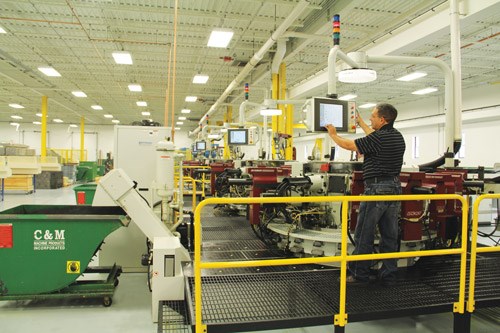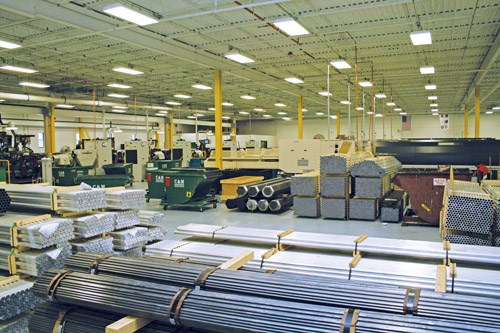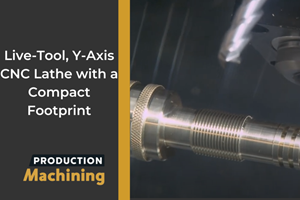Saving Lives with a Net
Every day, metalworking manufacturers contribute to the general and specific welfare of our nation’s economy by adding value and creating wealth. This New Hampshire shop has the added distinction of helping save the lives of our combat troops.
The soldiers of 2nd Platoon, B Company were amazed. Their new mine-resistant, ambush-protected vehicle had taken three direct hits by RPGs (rocket propelled grenades) while fighting insurgents in the Ghazni Provence of Afghanistan and none had penetrated the trucks. “The worst effect of the insurgents’ RPG fire was that I got my bell rung a bit,” says U.S. Army Pfc. Joseph Sweat from Smithville, Tenn. “The RPGs detonated at the nets, failing to penetrate the vehicle’s armor,” says U.S. Army Staff Sgt. Cameron Erisman from Hiram, Ga.
Wait a minute. Did he say “Nets?” Yep, that’s right, nets—Kevlar nets. U.S. Army 1st Lt. Matthew Ward from Herndon, Va., platoon leader of 2nd Platoon, B Company, 3rd Battalion, 187th Infantry, confessed he was skeptical about the nets. “I just didn’t think the thin net would be able to safeguard the vehicle and the soldiers from a rocket-propelled grenade.”
It turns out, the nets did exactly as advertised they would do, and all of the soldiers whose vehicles were hit by RPGs are alive today and still in the fight.
Called the Q-Net, it is a portable, lightweight RPG defense system using nets as an adaptable solution capable of providing RPG protection on a range of tactical and lightly armored vehicles. The design was developed jointly by QinetiQ North America, DARPA (Defense Advanced Research Projects Agency) and ONR (Office of Naval Research). The system is ultra lightweight, low cost and easily adaptable to a variety of platforms.
The Kevlar netting frames are installed 6 to 9 inches from the vehicle’s outer sheet metal using stand-offs. As an RPG approaches, the netting slows the momentum of the projectile enough that upon impact, it explodes outside the vehicle, rather than pierce its shell and detonate inside, saving our soldier’s lives.
Foster-Miller is the manufacturer and assembler of Q-Net products and was soon to let a contract that would dramatically change the way machine shop C&M Machine Products Inc. (Hudson, N.H.) think about and conducts business. It would also change the lives of the people working there.
The Life and Times of the ‘Gypsy Machinist’
For many years Gene Fantozzi, V.P. of operations for C&M, was known as the “gypsy machinist” in New England area shops. Mr. Fantozzi is a gregarious, likable guy, a confident leader and a jack of traits when it comes to metalworking. He’s picked up talents from many jobs in many shops over the years. One of those jobs became providential when in 1974 Mr. Fantozzi met the man who would become his mentor and friend, Sam Cole.
Mr. Cole was the plant manager for a machining shop called RBS. Mr. Fantozzi’s father was a postal carrier making his rounds when Mr. Cole asked him if he knew anyone who could possibly become a machinist and lathe operator, so Mr. Fantozzi was mentioned as a possible candidate.
“Sam came to see me,” Mr. Fantozzi remembers. “We talked, and I guess he liked what he saw, so he gave me a chance. He became like a second father to
me. Sam Cole knew more about machining than any-
one I have ever met.” It was knowledge that he would freely impart, and Mr. Fantozzi would soak it up. Later Mr. Cole left the company, and Mr.
Fantozzi, who didn’t want to carry on at RBS without his mentor, embarked on a multi-year journey, working for a number of machine shops along the way.
In 1979 a call came from his old friend, Mr. Cole. Little did Mr. Fantozzi know then, but he was about to retire his “gypsy” status. He returned to work with his mentor once again at a young company that had incorporated the year before. C&M was the new venture of Mr. Cole, the machinist ace, and Roger Martin, the businessman, who teamed up with silent partner Paul Villemaire to start the new company with six Brown & Sharpes and a truckload of knowledge and ambition.
“When I got there (C&M), we had the six Brown & Sharpes. Later, it would become 12, then 30, then 50. We were always growing,” Mr. Fantozzi recalls. “We added Bechlers and Petermanns; we even had Davenports at one time.” Today, C&M is a shop with about 75 Swiss machines, and a host of other machine tools.
When Mr. Cole retired in the early 1990s, Mr. Fantozzi took his position as shop foreman. Also upon his retirement, Mr. Villemaire, Mr. Cole’s son-in-law (and silent partner), stepped in to run the day-to-day operations, eventually buying out both founding partners.
Mr. Fantozzi always wanted to learn more, so soon after becoming the plant manager, C&M would add Cam Swiss Petermanns that he would teach himself how to operate by trial and error. Later, they went to CNC lathes. “We got Hardinges first, then later we added Mori Seiki,” he says, looking back. “Twenty years ago, we got our first Swiss (lathe), then we went from three, to ten, to 20 and more. Once I issued a single P.O. for 12 machines.” C&M was on a fast track to expanded business capacity.
The Real Volumes are Reveled
The hex component, known as the “hard point,” is an integral part of the Kevlar netting where the strands cross each other and are locked in place with a plug. If these parts fail, the net would be ineffective. The hard point starts its life as a 12L14 steel
5/8-inch hex bar. It receives a bore, two 90-degree slots and a pure flat cutoff end.
“We went through quite a few changes,” Mr. Fantozzi says. “It was the same basic design, but with different radii, edge breaks, lead-ins or possibly different dimensions. They do extensive shake tests for wear that simulates a vehicle traveling over rough terrain. We actually changed the radius of the plug several times because of the test results.”
As the process started, Foster-Miller gave them small batch quantities to run to make sure that C&M was up to the task. “We did the prototype parts on the Swiss lathes. The cycle time was 90 seconds, and at first we did 100 parts, then 1,000, 5,000 and 10,000 part runs,” Mr. Fantozzi recalls. “But once we had proven ourselves, and the real number Foster-Miller needed was given to us, we knew we couldn’t do them on Swiss lathes.” The requirement was 1 million hard point parts per week. That would require another building full of 25 or so additional Swiss machines to do the job, which was not feasible. They needed to get creative, fast. “We called Hydromat. I know the machine, and I know what they can do,” Mr. Fantozzi concluded.
A ‘Hard Point’ to Make
Mr. Villemaire and Mr. Fantozzi’s previous Hydromat experience gave them the idea to contact Kevin Hayes, northeast regional sales manager for Hydromat Inc. Mr. Hayes had been involved with C&M for several years before this RFQ came his way. “Mr. Fantozzi showed me the prints for the parts he needed to deliver quickly and in large quantities, and asked what I thought,” Mr. Hayes remembered. “I thought the applications would be ideal for the EPIC machines (from Hydromat), so we started the quoting process.”
C&M was predominately a Swiss shop that integrated themselves quickly into the world of high production rotary transfer runs. The decision to go with the EPIC R/T 16-station machines rather than the 12-station machines came down to volumes. To produce one million parts per week, a unique design was proposed by the Hydromat engineering department, which introduced the double-production, single index, two parts per cycle idea. “We thought that if we combine one drill, face the part, and put the counterbore in, then ream the ID, we could go to this double drop design,” Mr. Fantozzi says.
This solution was to feed two part length’s worth of bar into the collet, have enough cutoff and facing stock, and then work the first part on the first half of the machine, cut that part off and extract it. The remaining stock in the collet would then be machined on the second half of the machine with the same steps as the first half. The result: a 5.5-second cycle time that yields two parts, for an average of 2.75 seconds each. Now, the one million hard point parts per week quota was within reach with four, 16-station machines.
In normal cases, the routine of engineering, project modifications, machine building and run-offs can take 4 to 6 months. But, C&M, Foster-Miller and the troops in the field were in need of a quicker turnaround than normal. “We really jumped out on a limb,” says Dan Villemaire, C&M’s president. “One of the Hydromat machines was available in stock, so we bought it before we even had the contract. We were still in the bidding stage. We are confident in our ability to sell, so we knew that if the Q-Net order fell through, we would own the Hydromat, and we’d go out and sell jobs for it and make money.”
C&M did, in fact, get the contract and the push for the rest of the Hydromat machines, and a place to put them, was underway. “We were on an accelerated program, that’s for sure,” Mr. Villemaire says.
The hard point machines are now running in the low 90s in efficiency. Hydromat helped C&M get production started and spent 2 weeks there to get them up and running and train the six men who are now the Hydromat specialists. What has helped with the learning curve is that the EPIC CNC control, position by position, is basically programming either a one, two or three-axis unit, so it is similar to programming a multi-axis lathe, Mr. Hayes says. “The learning curve is quite short on the programming.”
All the hard work and long hours has paid off, C&M is now the sole supplier of hard point and plug parts for the Q-Net system, and the system’s implementation is growing to stationary buildings as well as motor vehicles.
Next up: the Clevis Part
C&M was running hard point production on two machines as Hydromat was building the third and fourth. As those production and machine-build processes were being completed, the design process turned to the “Clevis” part. This part starts as a 1.75 inch 6061 T6 aluminum round bar that, once machined, would become part of the Q-Net framework anchoring system.
As before, C&M didn’t know how many Clevis parts their client was going to require. “Originally, we had a supplier that was shipping 300 to 400 a week to us,” Mr. Fantozzi says. “Then Foster-Miller came up with the real number. It wanted 250,000 a week, and we thought, ‘Oh, my goodness!’ That’s when we called Hydromat.”
Another EPIC 16-station machine was designed to produce the part. Because of the size of the Clevis, the engineering team designed a machine with an oversized table and equipped it with a 16-ft. bundle bar feeder to cut down on bar change time loss and material handling. A triple chipbreaker tool helped with the chip management. Early on, the material started to fluctuate, with hardness changing within the bars, causing the stock to spin in the collets when an overly hard section of the bar was at the boring stage. Mr. Fantozzi originally was using mill runs, but was forced to change vendors and has consistency in the stock he now gets from Admiral. Changing to pecking, the through-hole and the added use of load monitors helped with the bore quality and with chip management.
Now, the Hydromat running the Clevis parts is at more than 80-percent efficiency, largely because of a massive amount of chips and chip management. This is one that Mr. Fantozzi is happy with. “It’s running in the sweet spot. We could push it up to 90 percent for a while, but it would result in problems that would push the overall efficiency down,” he says.
When making the Clevis part with an 11-second cycle time, a phenomenal amount of chips are produced when about 60 percent of the 1.75-inch diameter, 16-ft. bar is cut away, especially when one of these 16-ft. bars only lasts about 6 minutes. Referring to the chip management, Mr. Fantozzi says, “That was a work in progress. We had to make changes on the fly.” As time went on, they would bring these issues under control. “We bought a puck machine just for the scrap from this one Hydromat,” Mr. Fantozzi noted. “We also capture the Biolube oil for reuse.”
As production ramped up, another issue the company had to wrestle with reared its ugly head: the plating on the hard point parts. After the initial plating company, MFT, created a solution that could be consistently replicated and met all the specifications, it unfortunately could not keep up with the volumes once the final required quantities were made known. “We got it fixed when MFT went to three shifts,” Mr. Fantozzi says. “They do it all now.”
2010 was a Great Year
Successfully getting the Q-Net job was obviously a great learning experience for the younger Mr. Villemartie to see how his father operates and to see his dedication. “He was here working the machines himself, cleaning off parts, whatever it took to get the job done,” he recalls. “It was an invaluable learning experience.” His challenge, as a 28-year-old president, is gaining the respect of his customers and his staff as a young man in a business with an older demographic. “I learned from my dad that you have to work the hours and earn respect from people.”
Talking about the past year and beaming with pride, Mr. Fantozzi says, “We went from $15 million to more than $40 million in sales in a matter of months. We went to working three shifts, 24/7. What a great year 2010 was.”
The future looks bright for C&M as they break ground for a 50,000-square-foot addition to the new building that houses the Hydromat machines. With the addition comes new offices and a new facade for what is to become their new headquarters in 2012. Their current building will be transformed to more of a warehouse space than production, although some machines will remain. The Hydromat machines have given Mr. Villemaire a new outlook on production machining and its profitability. “We will look for more rotary transfer work. If we find the business, we’ll buy more Hydromats,” he concludes.
For Foster-Miller, C&M, Hydromat and the American soldier in the field, the Q-Net system has been a welcome bit of new defense technology. Everyone wins—except the bad guys.
Related Content
Video Tech Brief: Live-Tool, Y-Axis CNC Lathe with a Compact Footprint
This small footprint, big-bore lathe offers a generous work envelope. The addition of Y-axis and live tooling enables milling, drilling and tapping for increased machine capabilities.
Read More5-Axis Machining Centers Transform Medical Swiss Shop
Traditionally a Swiss machine shop, Swiss Precision Machining Inc. discovers a five-axis machining center that has led the company to substantial growth. (Includes video.)
Read MoreNomura DS Showcases Turning and Milling Machines Engineered with Excellence
Gosiger offers the comprehensive line of Nomura DS machine tools at competitive prices.
Read MoreWhen a CNC Turn-Mill Doesn’t Turn
A shop in Big Sky Country uses a B-axis multitasking machine to produce complex, prismatic medical parts that require no turning complete from barstock.
Read MoreRead Next
A Tooling Workshop Worth a Visit
Marubeni Citizen-Cincom’s tooling and accessory workshop offers a chance to learn more about ancillary devices that can boost machining efficiency and capability.
Read More5 Aspects of PMTS I Appreciate
The three-day edition of the 2025 Precision Machining Technology Show kicks off at the start of April. I’ll be there, and here are some reasons why.
Read MoreDo You Have Single Points of Failure?
Plans need to be in place before a catastrophic event occurs.
Read More










.jpg;maxWidth=300;quality=90)





.jpg;maxWidth=300;quality=90)








